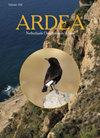黄鹀、白头松鹀及其杂交种对杂交区非种和异种鸣叫回放的响应
IF 0.8
4区 生物学
Q3 ORNITHOLOGY
引用次数: 0
摘要
黄鹀(Emberiza citrinella)和松鹀(Pine Buntings E. leucocephalos)在亚洲西北部约2500公里宽的同域区杂交。在这个区域的中心,在过去的50年里,黄斑蝶和中间(即杂交)表型的雄性已经取代了松斑蝶表型。相比之下,在该地区的南部,松树狩猎表型仍然很常见。在这项研究中,我们询问雄性之间是否存在依赖于其表型的行为不对称,以及这种不对称是否可以解释在杂交区不同部分观察到的表型组成。该研究于2017-2019年在杂交区南部的俄罗斯阿尔泰共和国进行。黄锤之歌和猎松之歌大体相似,尽管它们在细节上有所不同。这两个物种在叫声的使用上也有所不同:“see”的叫声对黄鹀来说更有特点,而“zieh”的叫声更常被Pine Bunting使用。我们使用对比刺激进行了回放实验,以评估对(1)Pine Bunting歌曲与yellow whammer歌曲的反应,以及(2)带有“zieh”叫声的歌曲与带有“see”叫声的歌曲的反应。实验表明,黄锤和杂交雄性对其他雄性的攻击性比具有松猎表型的鸟类更强。因此,后者在领土获取和维护方面可能处于不利地位。与此同时,任何表现型的雄性对黄鹀鸣叫的反应都比对Pine Bunting鸣叫的反应强烈,对“see”鸣叫的反应比“zieh”鸣叫的反应强烈。这可能会抵消不同表现型在领土竞争中的竞争能力,从而使松猎雄避免在杂交区南部被更具侵略性的黄斑蝶和杂交雄所取代。本文章由计算机程序翻译,如有差异,请以英文原文为准。
Responses of Yellowhammer Emberiza citrinella, Pine Bunting E. leucocephalos and Their Hybrids to Playbacks of Con- and Heterospecific Songs and Calls in a Hybrid Zone
Yellowhammers Emberiza citrinella and Pine Buntings E. leucocephalos hybridize in a c. 2500 km wide sympatric zone in northwest Asia. In the centre of this zone, over the last 50 years males with Yellowhammer and intermediate (i.e. hybrid) phenotypes have been replacing the Pine Bunting phenotype. In the southern part of the zone by contrast, the Pine Bunting phenotype is still common. In this study, we asked if there is a behavioural asymmetry between males depending on their phenotypes and whether this asymmetry can explain phenotypic compositions observed in different parts of the hybrid zone. This study was performed in 2017–2019 in Altai Republic, Russia, in the southern part of the hybrid zone. Songs of Yellowhammer and Pine Bunting are generally similar, although they differ in details. The species also differ in usage of call repertoires: the ‘see’ call is more characteristic for Yellowhammer, while the ‘zieh’ call is used more frequently by Pine Bunting. We performed playback experiments using contrasting stimuli to evaluate responses towards (1) Pine Bunting song vs. Yellowhammer song and (2) songs coupled with ‘zieh’ calls vs. songs coupled with ‘see’ calls. Experiments showed that Yellowhammer and hybrid males were more aggressive towards other males than were birds with the Pine Bunting phenotype. Therefore, the latter might be at a disadvantage in territory acquisition and maintenance. At the same time, males of any phenotype responded more strongly to Yellowhammer playback than to Pine Bunting playback, and to the ‘see’ call than to the ‘zieh’ call. This might counterbalance the competitive ability of different phenotypes in territorial competition, thus allowing Pine Bunting males to avoid being displaced by more aggressive Yellowhammer and hybrid males in the southern part of the hybrid zone.
求助全文
通过发布文献求助,成功后即可免费获取论文全文。
去求助
来源期刊

Ardea
生物-鸟类学
CiteScore
2.10
自引率
0.00%
发文量
49
审稿时长
>12 weeks
期刊介绍:
Ardea is the scientific journal of the Netherlands Ornithologists'' Union, and is published since 1912. The journal welcomes manuscripts reporting significant new findings in ornithology, in particular those covering the ecology, life history, and evolution of birds, and including sound descriptive work. Ardea publishes Original research papers, Short notes and Book reviews. In addition to the regular three issues per year, Ardea publishes specials that contain conference or workshop proceedings (produced on request).
 求助内容:
求助内容: 应助结果提醒方式:
应助结果提醒方式:


